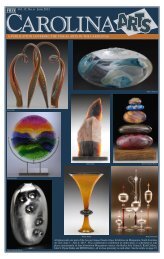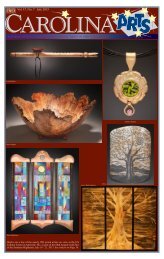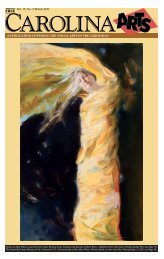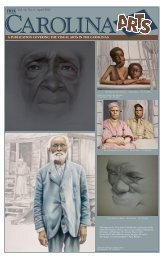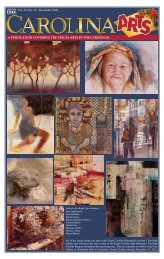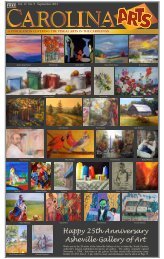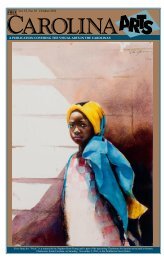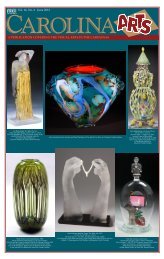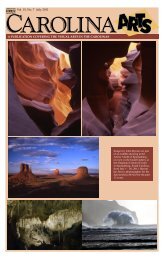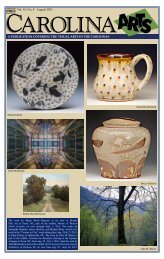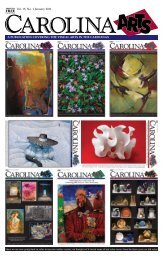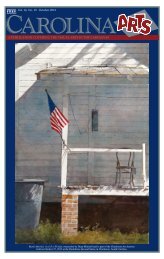Vol. 16, No. 9 September 2012 - Carolina Arts
Vol. 16, No. 9 September 2012 - Carolina Arts
Vol. 16, No. 9 September 2012 - Carolina Arts
You also want an ePaper? Increase the reach of your titles
YUMPU automatically turns print PDFs into web optimized ePapers that Google loves.
McColl Center for Visual Art<br />
continued from Page 10 / back to Page 10<br />
ticipation using a polling station designed to<br />
reference the various types of voting situations<br />
employed throughout the world.<br />
Imminent Disaster (aka Robyn Hasty) is<br />
a multi-disciplinary artist who follows the<br />
thematic thread of collapse and the potential<br />
for re-growth. Using a variety of media, she<br />
works in large-scale collaborative installations<br />
and meticulous technical projects.<br />
Hasty lives her life as art, creating projects<br />
that challenge and inform. Her work in<br />
American <strong>No</strong>w will be built from fragile<br />
materials, only to self destruct over the<br />
course of the exhibition, as a metaphor for<br />
the world’s current political systems.<br />
Greg Haberny utilizes the medium of<br />
installation and integrates a multi-faceted<br />
artistic vision to create a space that evokes<br />
excitement. Mixing influences from Alfred<br />
Hitchcock to Terry Richardson, Haberny’s<br />
assimilation and adaptation of cultural<br />
iconography remain true to themselves. A<br />
student of art, filmmaking, and photography,<br />
Haberny’s work in America <strong>No</strong>w will<br />
transform into an environment that addresses<br />
current national issues while incorporating<br />
materials reminiscent of <strong>No</strong>rth <strong>Carolina</strong>.<br />
The Mint Museum Uptown, located in<br />
the Levine Center for the <strong>Arts</strong> in Charlotte,<br />
NC, is presenting two new exhibits<br />
including: VantagePoint X / Vik Muniz:<br />
Garbage Matters, on view through Feb.<br />
24, 2013 and Against the Grain: Wood in<br />
Contemporary Art, Craft and Design, on<br />
view from Sept. 1 through Jan. 27, 2013.<br />
Combining three-dimensional elements<br />
within a two-dimensional pictorial space<br />
to create visually and conceptually loaded<br />
images, Vik Muniz creates work that<br />
fosters a shift in visual perception as well<br />
as cultural preconceptions.<br />
Chris Stain is inspired by the graffiti<br />
movement that exploded in the 1980s in<br />
neighborhoods throughout America. He<br />
uses printmaking and street art to illustrate<br />
the struggles of the unrecognized and<br />
underrepresented individuals of society,<br />
striving to inspire compassion for the less<br />
fortunate. Stain’s work in America <strong>No</strong>w<br />
addresses the concept of public protest<br />
while adapting images that reflect historical<br />
themes of the working class.<br />
Ben Wolf is a sculptor whose work gives<br />
life to shape, color, and space in the form<br />
of site-specific installations. Abstaining<br />
from representational imagery, Wolf uses<br />
abandoned materials like rusted metal, rotten<br />
boards, and peeling paint to invite the<br />
visual journey of interpretation. His work<br />
in America <strong>No</strong>w will be an expression of<br />
waste and excess that utilizes the aesthetics<br />
of trash dumpsters as the basis of a large<br />
scale installation.<br />
For further information check our<br />
NC Institutional Gallery listings, call the<br />
Center at 704/332-5535 or visit (www.<br />
mccollcenter.org).<br />
Mint Museum Uptown in Charlotte,<br />
NC, Features Works by Vik Muniz<br />
and Contemporary Works in Wood<br />
in visual perception as well as cultural<br />
preconceptions.<br />
Muniz enlisted the help of young art<br />
students from Centre Especial, a nonprofit<br />
educational organization that he established<br />
in 2005, to create his Pictures of<br />
Junk series between 2006 and 2009. Similarly,<br />
Muniz’s Pictures of Garbage series,<br />
completed in 2008, was the result of a<br />
direct collaboration with members of an<br />
informal workforce, known as catadores,<br />
whose livelihood consists of scavenging<br />
recyclable materials from one of the largest<br />
landfills in the world, Jardim Gramacho,<br />
at the outskirts of Rio de Janeiro.<br />
Referencing historical and iconic<br />
works of art, these massive images were<br />
constructed out of discarded materials<br />
obtained from Brazilian landfills through<br />
a highly labor-intensive process. Muniz<br />
directed the activity from scaffolding<br />
several stories above as the students and<br />
catadores arranged the objects in layers<br />
to create visual and physical depth. The<br />
final incarnation of each was preserved as<br />
a photograph before the arrangement of<br />
objects was disassembled.<br />
Sonia Handelman Meyer, Boys, Spanish Harlen (19B1), 1/25, circa 1946-50/2007, gelatin silver photograph, 14 x 14 inches<br />
a r t c o n s u l t a n c y<br />
The Birth of Venus, after Botticelli (Pictures of Junk),<br />
Vik Muniz (Brazilian, 1961-), 2008, Digital C-print,<br />
3 parts, 92 x 153 inches overall. Courtesy of the<br />
artist and Sikkema Jenkins & Co. Art © Vik Muniz/Licensed<br />
by VAGA, New York, NY.<br />
“The beautiful thing about garbage is<br />
that it’s negative; it’s something that you<br />
don’t use anymore; it’s what you don’t<br />
want to see. So if you are a visual artist,<br />
it becomes a very interesting material to<br />
work with because it’s the most nonvisual<br />
of materials. You are working with<br />
something that you usually try to hide,”<br />
says Muniz.<br />
Muniz was born into a working-class<br />
family in São Paulo, Brazil in 1961. Relo-<br />
garbage really is - environmentally,<br />
cating to the United States in 1983, Muniz<br />
socially, and culturally - and allows us to<br />
has since become one of the most well-<br />
see how the objects we consider garbage,<br />
known contemporary Brazilian artists<br />
most often characterized by its very lack<br />
working today. Beginning his career as a<br />
of consequence, matter.<br />
sculptor in the mid-1980s, Muniz became<br />
The exhibition, Against the Grain: Wood<br />
increasingly interested in photographic<br />
in Contemporary Art, Craft and Design, ex-<br />
reproductions of his work, leading him to<br />
amines woodworking in contemporary art<br />
turn his attention wholly to photography.<br />
and engages aspects of art, craft, and design<br />
Throughout his career, Muniz has cre-<br />
that have been characterized as “performaated<br />
multiple series of photographs, each<br />
tive” and critique the traditional art/craft/<br />
prefaced with the phrase “Pictures of” and<br />
design divide.<br />
in which he has used of variety of uncon-<br />
The exhibition demonstrates how 20th<br />
ventional materials, including dirt, sugar, Corner Chair, by Jackie Ferrara, 1998, Cedar, 33 x and 21st century creators have engaged the<br />
chocolate, wire, and garbage. Muniz<br />
consciously enacts playful contradictions<br />
36 x 36 in. Courtesy of the artist. Photo by Patz<br />
Imaging.<br />
medium of wood with conceptual and technical<br />
strategies. This timely exhibition ad-<br />
upon the surfaces of these photographs, The viewers’ perceptions of the phodresses a heavily debated topic in the field:<br />
as they are at once literally pictures of the tographs change as they draw closer to as the boundaries between art, craft and<br />
materials out of which they are con- and farther from the surface. Likewise, as design increasingly overlap, should these<br />
structed - in this case garbage - as well as the viewer spends more time with each categories be redefined, and if so, how?<br />
pictures of the images formed through the work, it becomes increasingly apparent In Against the Grain, the versatile me-<br />
transformation of the materials. Combin- how much the material out of which the dium of wood is used to address this issue,<br />
ing three-dimensional elements within a image is constructed informs its meaning. exploring postmodern tendencies includ-<br />
two-dimensional pictorial space to create Collectively, this body of work enlightens ing mimicry, assemblage, virtuosity, and<br />
visually and conceptually loaded images, and urges us to consider how important whimsy (with a serious purpose), as well<br />
Muniz creates work that fosters a shift<br />
continued above on next column to the right as environmental issues associated with<br />
Page 12 - <strong>Carolina</strong> <strong>Arts</strong>, <strong>September</strong> <strong>2012</strong><br />
Table of Contents<br />
Sonia Handelman Meyer<br />
1940’s Era Photographs<br />
of New York City<br />
Providing expertise to businesses<br />
and individuals.<br />
Connecting the public with artists<br />
in meaningful ways through<br />
projects, programming and<br />
community partnerships.<br />
118 East Kingston Avenue<br />
Suite 25<br />
Charlotte, <strong>No</strong>rth <strong>Carolina</strong> 28203<br />
704.334.3799<br />
www.hodgestaylor.com<br />
woodworking. The exhibit debuts at The<br />
Mint Museum followed by a presentation at<br />
the Museum of Art and Design in New York<br />
(Feb. - May 2013).<br />
There are approximately 60 works in the<br />
exhibit including vessels, furniture, sculptures,<br />
paintings, installations and works<br />
created since 2000 by an international roster<br />
of artists, craftspersons, and designers such<br />
as Alexandre Arrechea, Martin Baas, Gary<br />
Carsley, Andrew Early, Maria Elena Gonzalez,<br />
Silas Kopf, Mark Lindquist, Sofia<br />
Maldonado, Matthias Pliessnig, Martin<br />
Puryear, Betye Saar, Hiroki Takada, Alison<br />
Elizabeth Taylor, and Ai Weiwei.<br />
The exhibition is organized by the Museum<br />
of <strong>Arts</strong> and Design, New York, NY,<br />
and made possible, in part, by the National<br />
Endowment for the <strong>Arts</strong>, with additional<br />
support from Larry and Madeline Mohr. It<br />
is brought to The Mint Museum through the<br />
support of Moore & Van Allen PLLC and<br />
Founders’ Circle Ltd.<br />
For more info check our NC Institutional<br />
Gallery listings, call 704/337-2000 or visit<br />
(www.mintmuseum.org).



